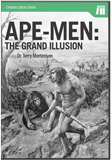
“Hobbit” Dispute Takes Another Turn
News Source
- ScienceDaily: “Anthropologist Confirms 'Hobbit' Indeed A Separate Species“
In last year’s August 26 News to Note, item #1, we reported on the then-latest classification status of skeletal remains discovered in 2003 on an Indonesian island. The remains, which are mostly from a single small human (now frequently referred to as a “hobbit”), were initially claimed as an extinct hominid species, Homo floresiensis. But three years later, an international research team concluded that the LB1 skull, as it’s been catalogued, instead belonged to a modern, dwarf human with microcephaly (an abnormally small, improperly developed head). This conclusion was partially an attempt to account for the “sophisticated tools and evidence of a fire” at the site.
Now there’s another twist: a Florida State University paleoneurologist claims the remains, dated to 18,000 years ago, really are from a different species. Dean Falk, whose team’s conclusions are published in this week’s issue of the Proceedings of the National Academy of Sciences, examined a “virtual endocast” of the “hobbit’s” braincase and compared it with “computer-generated reconstructions of nine microcephalic modern human brains and 10 normal modern human brains.” The result?
They found that certain shape features completely separate the two groups and that Hobbit classifies with normal humans rather than microcephalic humans in these features. In other ways, however, Hobbit's brain is unique, which is consistent with its attribution to a new species.
Thus, despite its small stature, it appears this hobbit may have had all the mental faculties of modern humans.
Interestingly, the researchers claim the hobbit’s brain is “highly evolved” and “advanced in a way that is different from living humans.” Thus, there’s no possibility evolutionists could claim this species (if it really should be classified as a separate species) as an evolutionary precursor to Homo sapiens. This leaves evolutionary scientists wondering the same things Falk is:
“It's the $64,000 question: Where did it come from?” she said. “Who did it descend from, who are its relatives, and what does it say about human evolution?”
Thus, despite its small stature, it appears this hobbit may have had all the mental faculties of modern humans. Whether or not it’s a separate species (originally defined to classify reproductive compatibility, though the definition has since grown stricter) may be tossed around for awhile (as with Neandertals); however, tool- and fire-making evidence indicates that this hobbit was likely a descendant of Adam and Eve.
Should this surprise Bible-believing Christians? Certainly not! After all, the Bible speaks of giants, and the average height of modern-day people groups ranges substantially. This simply attests (along with many other features) to the incredible diversity of God’s original creation.
For more on the topic of human origins and anthropology, see our Anthropology and Apeman Q&A.
For More Information: Get Answers
Remember, if you see a news story that might merit some attention, let us know about it! (Note: if the story originates from the Associated Press, FOX News, MSNBC, the New York Times, or another major national media outlet, we will most likely have already heard about it.) And thanks to all of our readers who have submitted great news tips to us. If you didn’t catch all the latest News to Know, why not take a look to see what you’ve missed?
(Please note that links will take you directly to the source. Answers in Genesis is not responsible for content on the websites to which we refer. For more information, please see our Privacy Policy.)
Recommended Resources

Answers in Genesis is an apologetics ministry, dedicated to helping Christians defend their faith and proclaim the good news of Jesus Christ.
- Customer Service 800.778.3390
- © 2024 Answers in Genesis




